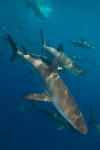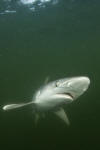Gulf of Mexico Sharks
September 25, 2009 by sharkdiverGulf Sharks
15th May 2009
The west coast and even Texas is already starting to blur. We are now driving around the Florida Panhandle looking for bluntnose and Atlantic stingrays to photograph. The last time I looked for stingrays here was way back in the point and shoot days long before I decided to become a ’serious’ photographer.
Last weekend we made the pilgrimage to Venice to dive with silkies and duskies. The duskies obviously didn’t get the memo but the oil rig that we dove at had so many silky sharks swimming around it that it was hard to remember that most shark species are endangered. For more than an hour we snorkeled around the boat in the presence of 100 or more sharks. The water was warm, the viz was great and the sharks were very, very friendly!
Venice is such a sharky place that it was the perfect location to reconnect with Eli, Paul and Nathan from Shark Diver Magazine. After two years apart we had a lot to catch up on and this was my first chance to introduce Claire to the team. Good times, good diving and some pretty good silky pics!
After Venice we drove east to the Gulf Coast Research Laboratory in Ocean Springs, Mississippi to meet with Dr Eric Hoffmeyer. Each month Eric and his team venture into the Mississippi Sound to monitor the shark population. The sound is home to thousands of small sharks, predominantly Atlantic sharpnose sharks but also finetooth sharks, bulls, blacktips, bonnetheads and a variety of other species.
Eric has collected a wealth of data on the sharks that migrate into his domain each summer and over two days out at sea I was able to sit and soak up more shark science than I ever thought my tired brain could handle.
Eric was kind enough to halt his work long enough for us to jump into the muddy water to photograph the sharpnose sharks that he released. The visibility was horrendous (about 3 to 4ft) but some of the images that we managed to get are surprisingly clear. One more shark to add to the Elasmodiver Field Guide at the end of the tour.
The majority of sharks that are landed are tagged, measured, fin clipped, blood sampled and swiftly returned to the sound but a few of the sharks that come up the line are DOA. These are brought back to the lab for further analysis and Eric invited us to join him in the lab to document the dissection process. It was a side of shark research that I haven’t been exposed to very much and it was a bit gory but fascinating to watch this aspect of his work.
After our Florida leg we are planning to head back to MS to work with Eric again.
For the sharks,
Andy Murch








1 comment:
You can have fun of watching sea beauty and sea animals at Mexico. It is one of the best place you will get to see on the earth to see natural beauty and sea beauty.
bed and breakfast playa del Carmen
Post a Comment